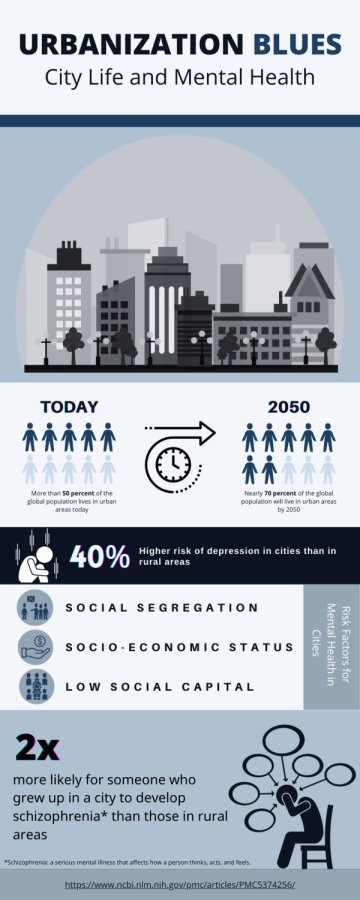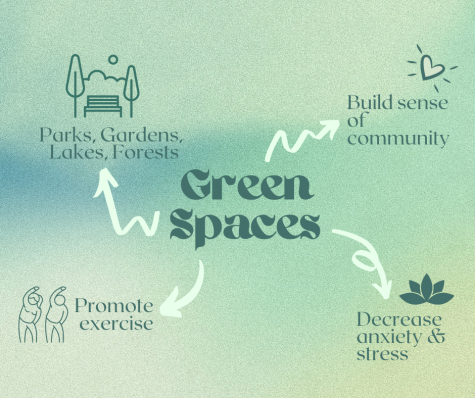
X: arianna_z_news

Twitter: @Katherine00718


Unveiling the hidden costs and consequences of urbanization and the vital role of green spaces.
May 29, 2023
“Starlight, star bright, first star I see tonight: I wish I may, I wish I might, have this wish I wish tonight.”
Gone are the days when young children could whisper these words to themselves as they stared out their windows into an endless starry night sky. Instead, today’s evening skyscapes are illuminated by blinking airplanes and harsh fluorescent lights radiating from the bulbs within buildings and street lamps.
Light pollution is only one of the many detriments of widespread urbanization. The construction of large urban centers and their increasing populations have created many stressors that affect daily life.
Some point out that constructing large cities offers many benefits, such as accessibility to job opportunities. However, its adverse effects are frequently overlooked, spurring urbanization to new, often harmful, heights.
For instance, city living promotes higher stress levels, which creates a need for more innovative stress-relieving strategies, one of them being green spaces.
Allison Collins, the director of San Mateo County’s Outdoor Education program, understands nature’s profound impact on one’s well-being. Affectionately called “Outdoor Ed” by participants, the program offers fifth and sixth-grade students a chance to leave the traditional classroom setting and spend a week at camp in the wilderness.
“I live here on camp and love being in the forest. You can feel it when you’re here: that shift between the city’s busyness and the forest’s calmness,” Collins said.
Over the past few decades, migration from rural areas to urban cities has increased dramatically, inflicting harm on all aspects of life, including mental and physical health. These consequences raise an essential question: do the benefits and opportunities created by urbanization outweigh the detriments?
Big cities have a constant hustle and bustle atmosphere, complete with crowded sidewalks and streets congested with vehicles. American author Patricia Marx sums it up well in her piece “Buy Shanghai!” in the New Yorker: “New York may be the city that never sleeps, but Shanghai doesn’t even sit down, and not just because there is no room.”
In modern media, the liveliness of cities is often romanticized as the dream destination for protagonists. Cities are shown as a land of opportunity — a fantastical world where anything is possible.

However, the media fails to portray the toll that the restlessness of cities takes on a city dweller’s mental health, creating a sense of ignorance towards the drawbacks of urban living. The busy lifestyle of cities can quickly become a stressful environment for visitors and residents alike.
“In general, we find that people living in cities have more mental health risks and have the highest anxiety levels. People living in suburban areas have the lowest levels, and then rural is somewhere in between,” said Dr. Ross Avilla, a professor of psychology at the University of California, Merced. Avilla also holds a doctorate in psychology from the University of California, Davis.
Additionally, according to a study published in the National Library of Medicine, urban air, water, and noise pollution significantly affects the mental health of urbanites. For instance, increased vicinity to major streets or airports elevates exposure to traffic noise and pollution and is linked to higher levels of anxiety and aggression.
“Between being overstimulated, pollution, and noise, we know people in cities have difficulty sleeping. There are much higher rates of insomnia in cities because the lights constantly shine in your window, and you’re always hearing traffic outside,” Avilla said.
The constant light exposure in urban cities confuses the day-night system in the human body — called the circadian rhythm — and changes sleeping patterns. Irregular sleep habits can negatively affect one’s mood and contribute to numerous health problems, including depression and anxiety.
Furthermore, city residents are more likely to feel a profound sense of loneliness than those living in suburban or rural areas.
“It’s ironic that urban residents have more people around them but typically experience more loneliness because they spend less time with people they have a good connection with, like family and friends. They are much less likely to be around relatives because most of them move away from family to live in a city,” Avilla said.
The lack of social support in cities also contributes to the social alienation urbanites feel. A robust support system nearby is crucial to maintaining a healthy mental life, so city residents are often disadvantaged.
“You would hope that when people are lonely and feeling overwhelmed, they will cultivate more supportive social networks, but it can be hard. It’s this process where you feel down, so you don’t feel like going out and socializing, which makes you feel even worse, creating a spiral people get caught in,” Avilla said.
Moreover, being in crowded situations is naturally anxiety-inducing because of the increased stimuli the brain has to process; due to the populous nature of cities, urbanites are more likely to experience social anxiety than others. In fact, urban residents are 21 percent more likely than rural residents to have anxiety disorders.
“People in cities have more social interactions, but they’re typically more superficial and stressful. City residents are usually forced to interact with strangers on a daily basis, which can be difficult for some” Avilla said.
Popular media usually does not show urbanization’s toll on visitors and residents, so many are unaware of the silent mental health epidemic occurring in the world’s big cities. From insomnia to depression, urbanization is undermining the quality of daily life.
Not only does urbanization impact mental health, but also physical health. From air pollution to cramped workspaces, the negative influences of cities on the human body are apparent.
“One of the issues we see in cities is that people aren’t moving enough. They tend to sit in front of technology for long periods, which increases the risk of a variety of adverse health effects, including things like diabetes and obesity,” said Dr. Alan Hedge, a professor emeritus of ergonomics at Cornell.
City jobs and workspaces encourage a sedentary lifestyle for its workers because employees have few opportunities to move around during the workday, creating a host of physical problems for them.
“There are four main problems caused by a sedentary lifestyle. Number one is back problems. Number two involves the hand and wrist. Number three revolves around vision, and number four is circadian problems,” Hedge said.
Back issues are typically attributed to incorrect postures and poorly designed office products, like chairs and desks. Hand and wrists problems include disorders like carpal tunnel syndrome, often caused by frequent mouse and keyboard usage.
Vision problems are usually caused by excessive use of electronic devices, specifically, overexposure to the blue light they emit. Circadian issues are also correlated to blue light emission; using devices right before bed changes your body’s internal clock, which can cause insomnia and daytime drowsiness.
Aside from workplace injuries from office jobs, air pollution is another major concern in urban cities. Urbanization and cities have created more centralized populations, causing more pollutants to be emitted into the air surrounding cities.
Busy streets filled with aggressive honking are commonplace. Aside from its role as a common stressor to the mental health of urbanites, it also contributes to the air pollution found in cities and is detrimental to one’s physical health. This is observed through a study of over 57,000 women, which revealed that living near major roadways increases women’s risk for breast cancer. Cities often have more major roads, putting more people at risk of illnesses.
The World Health Organization has also discovered that air pollution is associated with 6.7 million deaths annually. They have named motor vehicles, household combustion devices, and forest fires as a few of the common factors for air pollution. Alongside the risk of breast cancer, air pollution also increases the risk of lung cancer, respiratory infections, and heart disease.
Air pollution’s increased risks for numerous severe illnesses and the fact that cities frequently serve as a hotspot for poor air quality reveals how urbanites will likely face more health risks than usual. The crowded environment is a means for more contributors to air pollution and more people suffering from these severe illnesses.
So how do all these problems tie into urbanization?
Urbanization has increased exposure to these problems and difficulties in resolving them. Several are infused within a city’s overall environment and culture, creating many hurdles when searching for solutions. Problems introduced by the sedentary lifestyle and air pollution are widespread, making them hard to counter. However, there is a solution.
Central Park in New York City. Golden Gate Park in San Francisco. Lincoln Park in Chicago.
All three are examples of sprawling green spaces built amid large urban areas. These spaces create pockets of nature within the busy, concrete scenery of cities and can be parks, lakes, forests, gardens, and more.
Incorporating nature in cities through the development of green spaces combats both the mental and physical health issues created by urbanization.
“We know that when people spend more time in nature, they feel better and have better mental health outcomes. There’s not as much stress. In general, nature is synonymous with taking time for yourself and relaxing, spending time with family and friends, and doing things in a nice, quiet environment,” Avilla said.

The greenery and calmness in parklands are a direct contrast to raucous, gray cities, encouraging the anxiety and stress from city living to melt away. The simple act of being in a natural, uncultivated environment can be a mental reset for people under constant stress.
San Mateo County’s Outdoor Education program is an excellent example of the metamorphic effects of nature. When students first arrive in the forest for the program, they’re immediately immersed in the wilderness.
“You get off the bus, and you’re immediately in this beautiful, forested area: the ground is uneven, with roots and fallen logs. Kids are climbing over things and picking up stuff they find on the ground, and that is the hands-on connection that students get to have with nature and the environment at Outdoor Ed. It’s transformational,” Collins said.
Natural settings provide both kids and adults with a sense of peace and wonder. Green spaces provide a highly beneficial service as they give solace to urban residents wishing to take a break from the fast-paced city life. They also double as areas to exercise.
“Green spaces are very valuable. They tend to encourage you to want to walk around in those spaces or move around, which can alleviate some of the detriments of the sedentary lifestyle of cities. It’s good to have green spaces and safe routes through those areas that people can use regularly,” Hedge said.
Research from Denmark’s University of Aarhus discovered that city residents living without any green spaces nearby had up to a 55 percent increased risk of developing psychiatric disorders like depression and substance abuse.
“Cities with many parks and green areas interspersed throughout communities had fewer mental health issues,” Avilla said.
However, despite the apparent benefits of green spaces, many believe they are too expensive and not worth the investment. For instance, Central Park in New York City cost $14 million to build.
People concerned about the expenses must realize that green spaces are becoming more of a necessity and less of a luxury. Mental health disorders have increased by 13 percent in the past decade, with urbanites being most vulnerable, so parklands in cities are increasingly vital to maintaining a high quality of life.
Collins has observed the joy and carefree attitude that kids and adults alike have experienced from being in nature.
“Watching children interact in this space, where they’re singing a song in front of a cracking campfire or watching the waves on the beach, is a calming experience for our staff,” Collins said.
While the continuation of urbanization is inevitable, community members and city designers can confront the concrete consequences of city building and decide to change how the world urbanizes. If this is possible, then who knows?
Maybe someday, kids will be able to wish upon a star once again.

